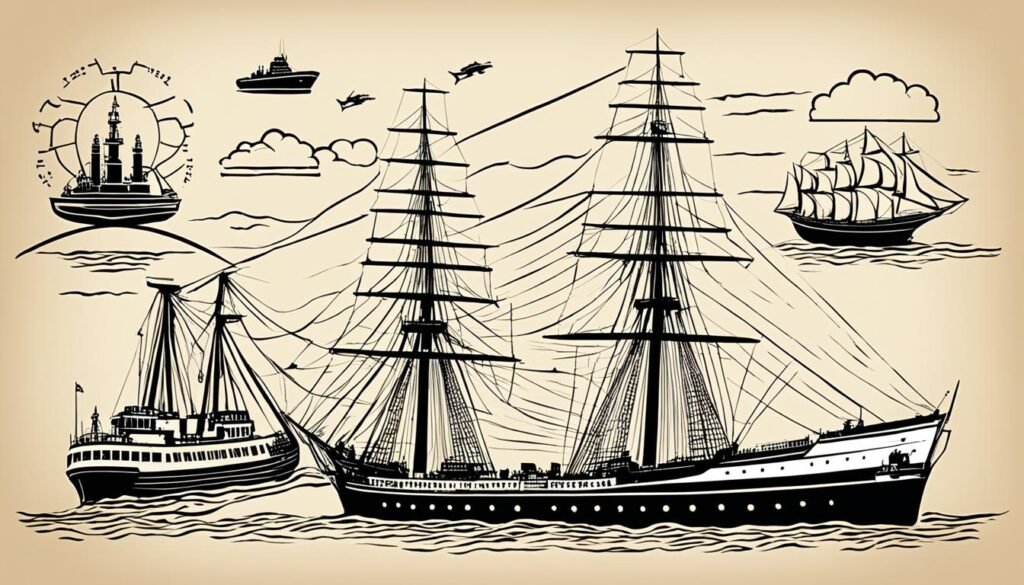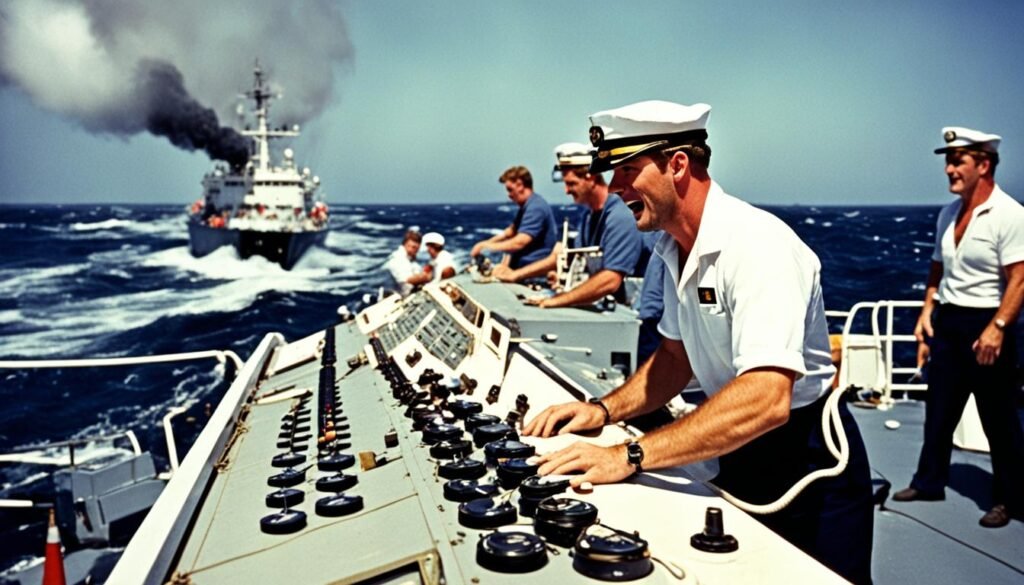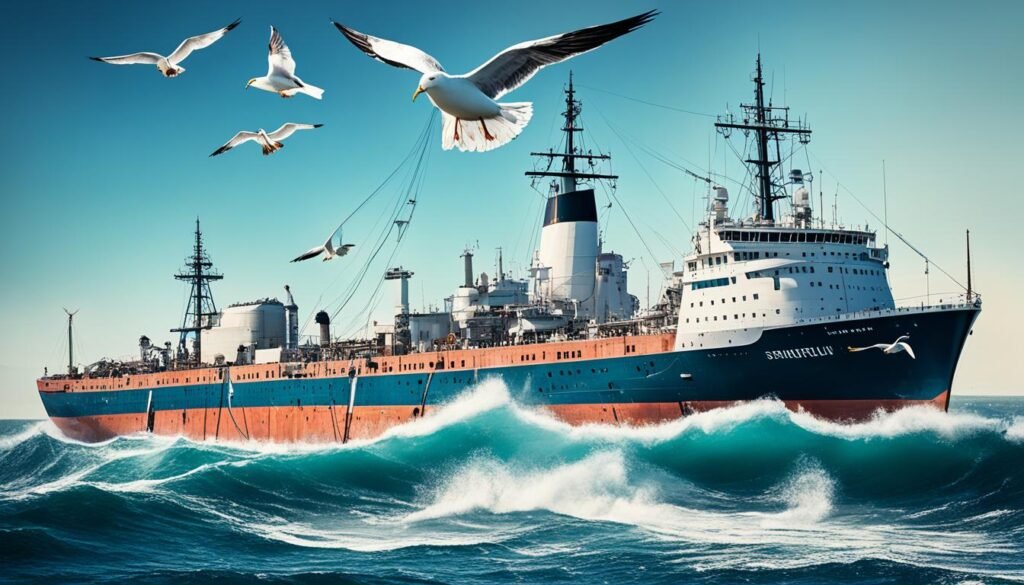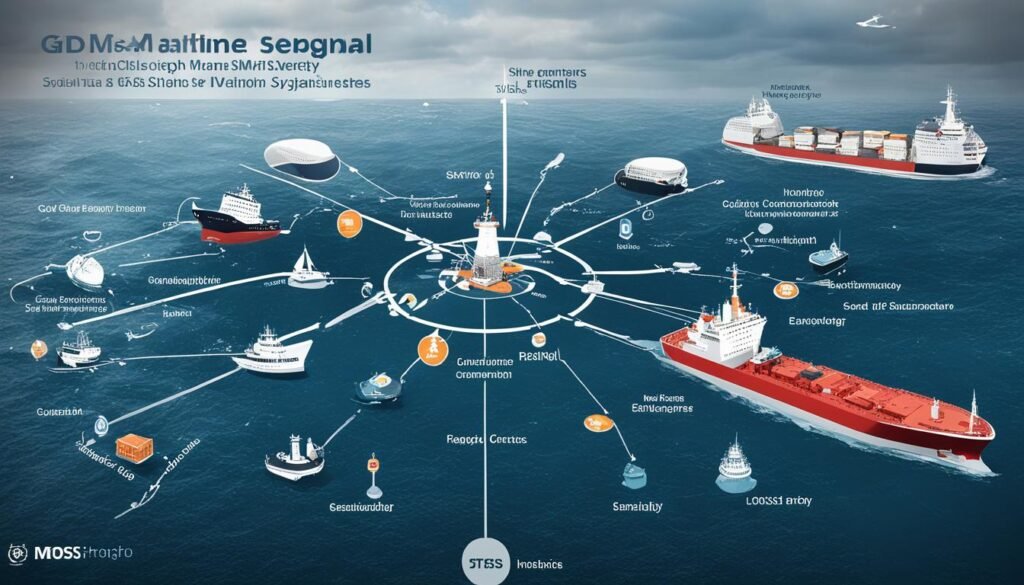Imagine sailing on vast, uncharted waters, guided by wind and stars, centuries ago. Back then, talking to the outside world was a luxury, not a need. But over time, maritime communications have changed how we navigate, interact, and keep our ships and crews safe.
This journey through maritime communication history shows the industry’s creativity and strength. It’s a story of how we’ve moved from simple signals to modern internet using satellites.

The evolution of the internet and communication on ships is full of innovation and a drive to improve safety and efficiency at sea. Let’s dive into this history. We’ll look at key moments that changed how we communicate and handle maritime challenges.
Early Maritime Communication Methods
At sea, early communication used simple visual signals. Ancient sailors used flags, torches, and smoke signals to send messages. These methods were basic and often failed due to bad weather and limited visibility.
Visual Signaling Techniques
The telegraph changed ship-to-shore communication in the 19th century. Samuel Morse invented the telegraph and the Morse code. This allowed for fast and reliable long-distance messages.
Coastal stations set up telegraph lines. Ships could send messages through these lines using semaphores with flags. Later, Morse code replaced semaphore, letting ships talk directly through telegraphy.
The Telegraph and Morse Code
Morse code uses 26 letters, numbers, and signals to send messages. It was key for ship-to-shore communication, helping with important messages and distress calls. The telegraph and Morse code were the main ways to communicate at sea until wireless radio came along in the early 1900s.

| Communication Method | Characteristics | Limitations |
|---|---|---|
| Visual Signaling | Flags, torches, smoke signals | Limited range, affected by weather |
| Telegraph and Morse Code | Rapid long-distance communication, standardized system | Reliance on coastal telegraph stations |
The Rise of Wireless Communication
In the late 19th and early 20th centuries, maritime communication changed a lot with wireless telegraphy. Guglielmo Marconi made big strides in wireless transmission. This led to the first ship-to-shore radio communication in the 1890s.
At first, this new tech used spark-gap transmitters and Morse code. It lets ships send and receive messages over longer distances than before.
Radio Communication and the Titanic Tragedy
The sinking of the RMS Titanic in 1912 showed how crucial radio communication is in emergencies. It led to new global rules for wireless communication at sea. These rules included needing backup power and trained operators on big ships.
The Titanic’s wireless system, from the Marconi Company, could reach up to 1,600 kilometers away. But it was too late to save most people on board.
Advancements in Voice Communication
Adding voice communication to ships made talking at sea much easier and faster. By the early 20th century, radios on ships could send voice signals. This made talking with the shore much better.
These changes in maritime satellite communications and seafarer telecommunications advancements changed how ships connect with the shore. They made vessel connectivity advancements and oceangoing internet access better.

Global Maritime Safety and Distress Systems
The International Maritime Organization (IMO) launched the Global Maritime Distress and Safety System (GMDSS) in the 1980s. It aimed to boost maritime safety and improve communication. GMDSS uses satellite systems, high-frequency radio, and digital selective calling (DSC). This system sends out distress signals, reports positions, shares weather info, and lets ships talk to each other.
GMDSS works in four areas: A1 (VHF coverage up to 30 nautical miles), A2 (MF coverage up to 150 nautical miles), A3 (HF and Inmarsat SATCOM below 70°N and above 70°S), and A4 (polar regions requiring HF radio with DSC). It includes:
- Emergency Position Indicator Radio Beacon (EPIRB) – sends signals on the 406MHz frequency through the COSPAS-SARSAT Satellite System
- Search and Rescue transponders – work on “X” and “S” radar frequencies
- Digital Selective Calling (DSC) – sends data on maritime radio and is a distress and call system
- Maritime Safety Information (MSI) and NAVTEX – share navigational and weather info
It’s important to check and keep GMDSS gear in good shape. This includes VHF radios, MF/HF radios, NAVTEX receivers, AIS transponders, and Search and Rescue transponders. The Futronic MKII test box by Danphone is a key tool for these checks.
New tech like NAVDAT and VHF Data Exchange System (VDES) is coming. They will boost capacity and speed for warnings, forecasts, and emergencies. This will make ship-to-shore communication networks and maritime data transfer even better.

How Internet and Communications Evolved on Ships
Satellite Communication Revolutionizes Connectivity
Satellite technology changed how ships talk to each other and the shore. It covered the whole world, solving the problem of land-based systems. In the 1970s, INMARSAT launched the first system for maritime communication through satellites. This allowed ships to send voice and data in real time.
Later, satellites got better, making it faster to send data, have video calls, use the internet, and manage ships better.
Digital Communication and Internet Access
Digital tech and the internet changed ship communication a lot. Ships started using digital ways to connect different systems like navigation and communication. They could get fast internet through satellites, making it easier to share information, check on ships, help crew, and handle documents online.
This change made the maritime industry more efficient and connected. It helped improve shipboard networks and made the industry more digital.
| Evolution of Ship-to-Shore Communication | Key Milestones |
|---|---|
| Visual Signaling Techniques | Flags and semaphores used for basic communication Limited to line-of-sight and daylight conditions |
| Telegraph and Morse Code | Enabled wireless communication using coded signals Revolutionized ship-to-shore data transmission |
| Radio Communication | Allowed for voice and data transmission beyond visual range Played a crucial role in the Titanic disaster response |
| Satellite Communication | Provided global connectivity, eliminating geographic limitations Enabled real-time voice, data, and internet access at sea |
Maritime Broadband and Crew Connectivity
The use of maritime broadband and satellite internet has changed how ships connect. Satellite communication systems like VSAT and Fleet Broadband give ships fast internet. This lets them send data quickly, have video calls, and improve crew welfare. New satellite tech, like high-throughput satellites and low-Earth orbit constellations, has made internet speeds and quality better, making it like what we have on land.
Satellite Internet for Ships
Shipboard networks and digital setups now support many systems, from navigation to crew talks. This digital transformation has made ships work better, safer, and improved crew life. Now, seafarers can easily access the internet, enjoy online fun, and talk to family and friends back home.
Fleet Broadband has made ship operations smoother by letting fast messages go between shore and ship. Companies now offer free broadband on ships to make life better for crew, keeping them happy and reducing staff turnover. Internet services on ships help keep the crew motivated to stay with the company longer.
| Metric | Value |
|---|---|
| The Earth’s surface consists of about | 71% ocean and 29% land |
| L band satellite frequency has been used for the | Global Maritime Distress and Safety System (GMDSS) for many years |
| High Throughput Satellites operating in Ka-band can offer vessels | higher bandwidth but require costly hardware |
| High Throughput Satellites operating in Ka band can offer vessels | download speeds over 100 Mbps |
| The Global Maritime VSAT Market was worth | USD 2.17 Billion in 2018 and is expected to reach USD 5.96 Billion by 2026, with a projected compound annual growth rate of 13.57% from 2019 to 2026 |
| Seafarers typically spend approximately | $75.00 to $150.00 per month on voice calls when using prepaid cards prior to the availability of internet on ships |
| Access to social networking sites such as Facebook, Twitter, and Friendster has become | effortless for seafarers with internet connectivity on ships |
| Internet on ships has significantly reduced the cost and need for using | prepaid cards and dongles to access the internet, marking a shift in communication methods |
Challenges and Future of Ship Communications
The maritime industry is going digital, but it faces big challenges. Keeping ship-to-shore data networks and vessel connectivity at sea reliable is tough. Weather, distance from land, and physical barriers can mess with marine broadband technology and vsat maritime connectivity. This makes shipboard telecommunications advancements and vessel connectivity solutions hard.
Marine satellite networks and shipboard internet advancements have changed sea communication. But, the industry still has hurdles. Seafarer communication innovations and offshore broadband technologies are key to closing the connectivity gaps. Wireless networking on ships and vessel data transmission can get interrupted, especially in far-off oceans.
Cybersecurity is a big worry for ship operators now. Seafarer telecommunications advancements and oceangoing internet access must be secure. We need strong security to keep sensitive info safe and protect maritime communication history from threats.
The future of shipboard internet evolution and vessel connectivity advancements is bright. New satellite tech, 5G networks, and IoT are changing maritime connectivity. They promise to bring a new era of data exchange, remote monitoring, and better crew welfare solutions.
You can also read this blog post for more information on Maritime communications – the current position and future development
Conclusion
The way ships communicate has changed a lot, making the sea safer and work more efficiently. From old visual signals to today’s satellite tech, we’ve seen big steps forward. Now, new tech like 5G, AI, and IoT could change ship communication even more, making sea travel better than ever.
New tech has made the sea more connected and efficient. Things like broadband at sea and better crew connections have changed the shipping world. Now, ships can talk to the shore and manage data better, making them safer and more efficient.
The future looks bright for ship communication and the internet at sea. With new tech in offshore and satellite communications, the sea is set for a big change. This change will bring new ways to connect and make ships more efficient, marking a new chapter in ship communication.
FAQ
How did maritime communication methods evolve?
Early sailors used flags, torches, and smoke signals to communicate. Later, the telegraph and Morse code came into use in the 19th century. Then, wireless telegraphy and voice communication were introduced in the late 19th and early 20th centuries.
What was the impact of the Titanic tragedy on maritime communication?
The Titanic’s sinking in 1912 showed how crucial radio communication is in emergencies. It led to new rules for wireless communication at sea.
How did satellite communication revolutionize ship-to-shore and ship-to-ship communication?
Satellites made global communication possible, overcoming the limits of land-based systems. They allow for real-time voice and data exchange. This has made sharing information, monitoring remotely, and improving crew welfare easier.
How did the adoption of maritime broadband and satellite internet transform connectivity at sea?
Maritime broadband and satellite internet, like VSAT and Fleet Broadband, have brought fast internet to ships. This has made real-time data transfer, video calls, and crew services possible. New satellite tech has also improved internet speed and reduced delays, making it more like land-based internet.
What are some of the ongoing challenges in maritime communications?
Keeping a steady, fast internet connection at sea is hard due to weather, distance from land, and physical barriers. Cybersecurity threats and the need for strong data systems are also big concerns for ship owners.
How are emerging technologies shaping the future of maritime connectivity?
New techs like 5G, AI, and IoT could change ship communication a lot. They promise to bring more connectivity and efficiency to the seas.
Read other related posts
